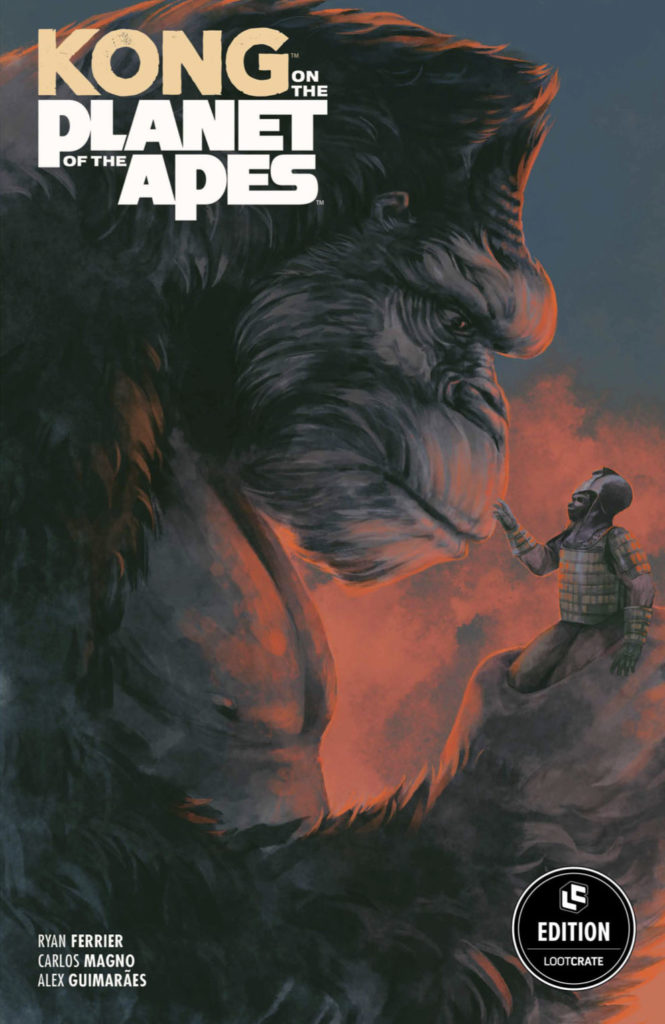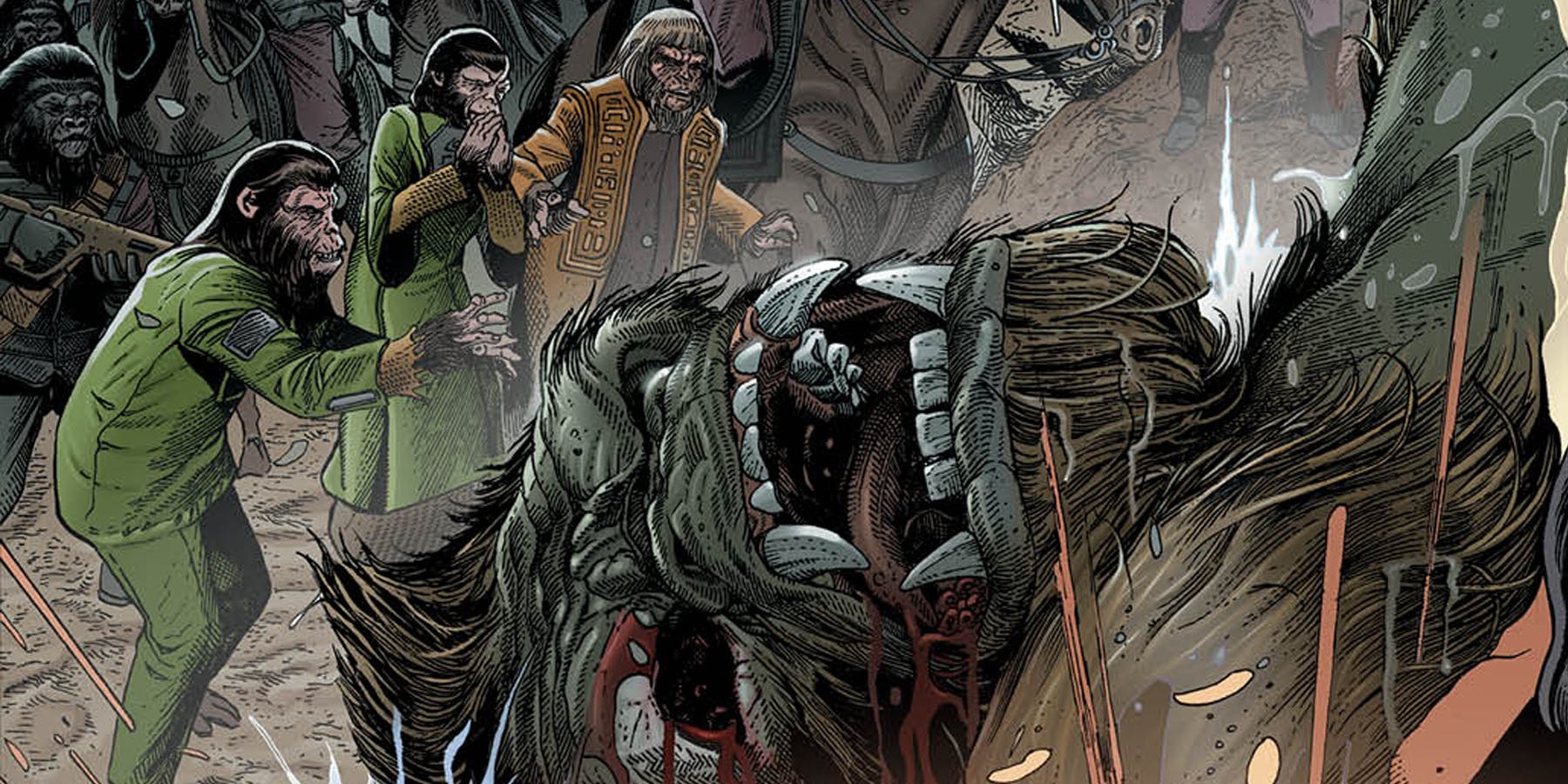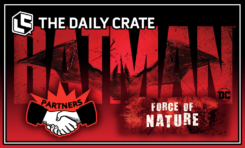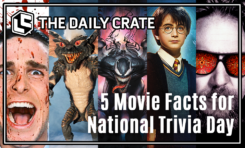SPOILER ALERT: This Q&A includes details around BOOM Studios’ Kong on the Planet of the Apes, as well as an item in the upcoming COLOSSAL Loot Crate DX. If you don’t want to be spoiled, bookmark this page and come back later; otherwise, proceed!…
In the past several years, one of the most fruitful franchises for crossover appeal in comics has been Planet of the Apes. Taking visual and storytelling cues from 20th Century Fox’s original film run in the 1970s, the futuristic Ape society has crossed paths with everyone from Star Trek‘s intrepid Starfleet (!) to that intergalactic harbinger of peace, the Green Lantern. (!!!) The fine folks at BOOM! Studios, however, may have delivered the perfect primate event storyline in their six-issue miniseries Kong on the Planet of the Apes, which sees the Ape society from the films rocked to its core with the discovery of a new species – a very ancient one from their perspective, whose discovery upends everything they know about their origins and relations with man.
As fans of both of these epic titles, we were thrilled to make Kong on the Planet of the Apes a part of our COLOSSAL theme this month; to commemorate, we took a deep-dive into the creation of the series with BOOM! Studios editor Dafna Pleban, writer Ryan Ferrier and artist Carlos Magno!:
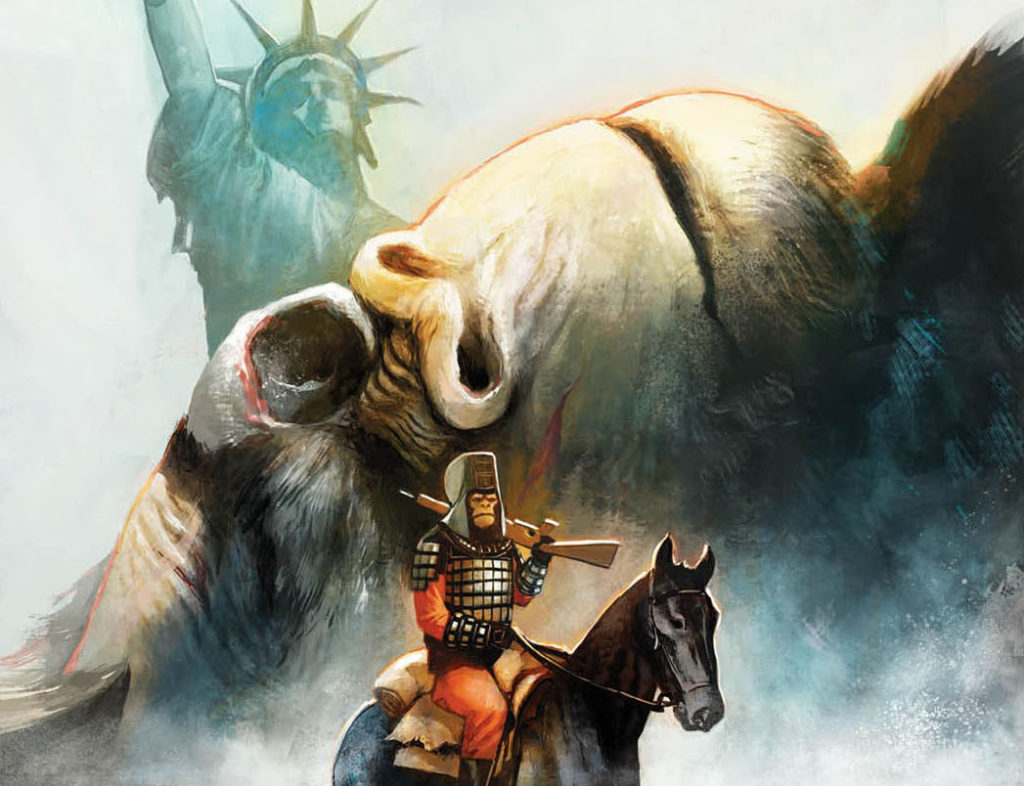
(BOOM! Studios)
There have been some very interesting Planet of the Apes crossover titles in recent years, but this one feels like a truly natural meeting of two great franchises. How did the project initially come about?
Dafna: It’s a bit of a no-brainer when you really think about it, huh? Especially since we publish both franchises and the wonderful Carlos Magno has played in both universes in really significant exciting ways! With the success of Planet of the Apes/Star Trek and Planet of the Apes/Green Lantern, it felt like a natural progression. Especially when both Carlos and Ryan would be available. I’ve worked with Carlos for most of my career, so it felt like a culmination of our time together — and Ryan has always been an incredible partner in this sort of stories. His imagination is pitch perfect for a crossover like this — he not only understands the Planet of the Apes and Kong universes, he knows why a fan would want to pick up this book (Apes riding dinosaurs! Kong decimating Ape City!) and makes sure we earn every moment of it.
Ryan: I know that Dafna is — maybe besides me — the biggest Planet of the Apes fan, and her work with all of the series has been truly phenomenal, so I can’t even imagine the excitement in the BOOM! Studios office when this series was brought up. I like to think it was our mutual adoration of the properties that brought my name into the mix. Nonetheless, they reached out to me about possibly writing the crossover, and I absolutely lost my mind at the prospect. We spent some time developing the story and exploring the possibilities, and now it exists. I couldn’t be happier.
Carlos: Although this never happened in my mind, the project seemed obvious to me, even when Dafna told me that we would join the two franchises. After a while, when I was already working on the first issue, I saw how unusual that encounter was. It was a perfect marriage that had never been thought of before.
For all of you, to what extent have you been fans of each franchise over the years?
Dafna: I’m ashamed to say my introduction to Planet of the Apes was when I was first assigned the book as an editor all those years ago. But I’ve become a rabid fan since then of both Kong and Apes.
Ryan: I am a massive fan. Like, massive. I’ve always had an interest in non-human characters, and a propensity for writing them in my work over the years. Planet of the Apes has always been, for me, that #1 fandom, from top to bottom. King Kong as well has been huge for me in my exploration of film and storytelling.
Carlos: I’ve always been a fan of the two franchises. I’ve always been in love with apes. Both Kong and Planet of the Apes were a fundamental part of my life, I think because my whole family respected and admired the two universes. I remember everyone stopped to watch both movies on TV.
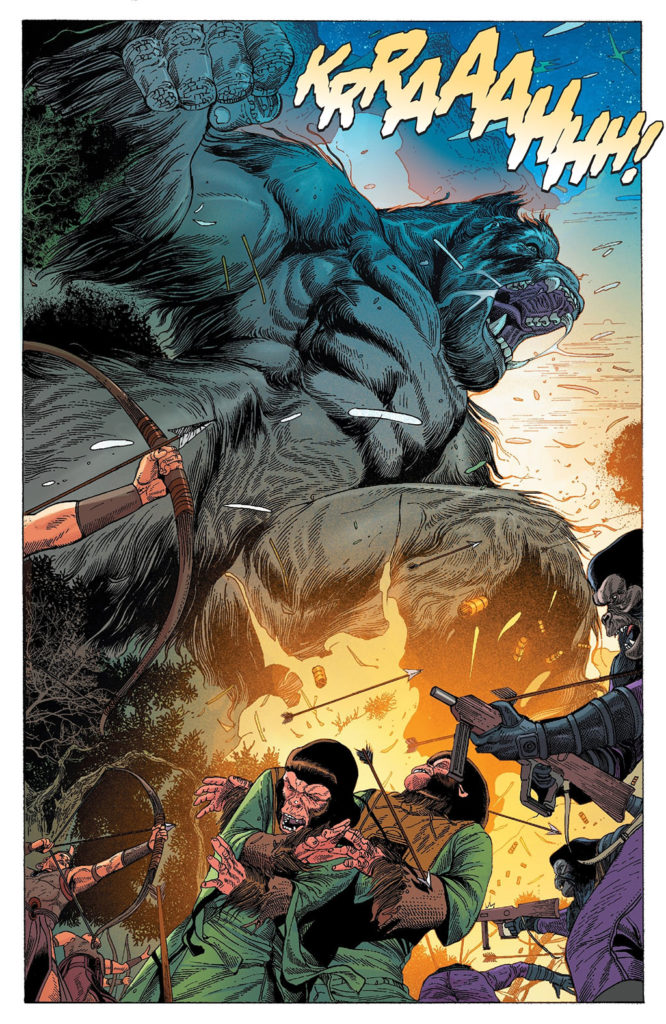
(BOOM! Studios)
Describe the approach you took, from a storytelling perspective, toward what the introduction of Kong would mean to the ape civilization as depicted in the original Apes film?
Dafna: It was surprisingly an easy fit — Skull Island being so isolated is part of its feature in the Kong universe, so it was conceivable that it would be in a similar state in Planet of the Apes. And the idea that humans are still intelligent, still able to speak and form communities would be a really interesting threat for Zaius and Ursus, so the conflict felt really tangible. Paired with a giant, feral Ape looking creature, you have the ingredients to examine the core anxieties of Ape society. Ryan really took those ingredients and ran with it.
Ryan: The addition of the Kong mythology fits pretty seamlessly in the Apes lore, while also allowing us to flesh out a huge aspect of the Apes world, namely religion. The wonderful, challenging thing about the characters at play in this story is that they all have very specific relationships with faith, and very different goals for themselves and how they see the Ape society growing. This also allowed us to take these characters in different directions for a moment; there are brief instances of, for example, Cornelius losing his footing in science, and Dr. Zaius briefly flirting with different balances of morality.
Carlos: It was as simple and direct as possible. Since we were creating something original based on these two already existing concepts, we had to be careful when dealing with the affective memory of fans of the two franchises. We knew it was a very, very delicate field. Therefore, I fully respected all the design created by John Chambers in the original Planet of the Apes and the one created by Mr. De Vitto for Kong. Experimenting with the franchises the fans love so much was a risk, but in the end everything worked out.
As we have seen in previous Apes comics, the different species of advanced apes have very particular subcultures and motivations. Which do you think was the most challenging to explore in this story?
Ryan: For as steadfast as the Ape society has been depicted, especially in the films, the political landscape of Ape City is actually really volatile. I think the most challenging aspect of dealing with this was tapping into the emotional, vulnerable sides of some of the characters. No one “jumps sides” so to speak, but we do see these beloved characters act in different ways based on emotions, once their beliefs are challenged by their awareness of Kong, and more specifically the presence of the unknown. We wanted these character threads to feel natural and justified. It was a delicate balancing act, but so rewarding to get deeper inside these characters heads.
Carlos: We introduced the African Coast Apes leaders in the first issue. In terms of character design, I thoroughly researched the culture of tribal leaders in the African region and brought some of that context into the ape culture. The result was very beautiful, because in many ways it was reminiscent of the concept created in the 1960s. It was interesting to see that all human cultures can fit perfectly in Planet of the Apes.
For each of you, which is your favorite of the original Apes characters to write/draw/explore their story?
Dafna: Doctor Zira! She’s my favorite in the films, and I love how Ryan writes her here — she’s unwavering her in her morality, in what is right and wrong. Ryan has her grapple in a really real way, the threat of Ape society on these peaceful humans even if she’s deeply curious and wants to learn more. She knows that her mere presence opens the door to greater threats from her society, but her curiosity gets the better of her. It’s incredibly human and tragic.
Ryan: Dr. Zaius has always had a special place in my heart, and I loved playing with his role a little in this story. For as ruthless as Ursus is, and as virtuous as Zira is, Zaius has a lot of intricacies. He’s incredibly complex. I would also be lying if I said writing the partnership of Cornelius and Zira was not a dream to play with.
Carlos: For me it was Ursus. I’ve always been in love with him. I love that long, oval helmet. For me, he is the maximum representative of the franchise. I made him bigger and more dangerous, even though he was already a bold and ruthless leader.
In addition, you’re weaving the Skull Island natives’ story into this narrative; this has existed in previous books and comics, but how did you seek to put your own stamp on it?
Ryan: Since we’re so far in the future — thousands of years — I found the Skull Island element incredibly interesting to think about. While the island has gone largely untouched—which explains their continued presence despite global catastrophe—we couldn’t have ignored the natural evolution of the island, in particular its natives. As such, we’re portraying these human characters with a little more nuance that isn’t always found in similar literature and media.
Carlos: We had already explored the universe of the people of the island in KONG OF SKULL ISLAND. It was not very difficult to create a new concept, because I took that old idea and put it in the future. It is amazing to see how they evolved within their habitat; their clothes, mounts, dwellings. I tried to draw them in a cleaner way too, portraying the total harmony they had with their world.

The character of Ni’Ta in particular stands out, and she’s a formidable challenge for the Apes in a completely different way than Taylor was. What inspired her?
Ryan: As a younger character that’s being forced into an older way of life, we wanted to explore the natural instincts of pushing back against that; Ni’Ta wants to find her place in the world, but her arc asks the question of how can she do that now that she knows there’s so much more outside of the island. While Taylor was thrown into an unknown world, Ni’Ta has access to the answers and as such, has opportunities to make her own choices, despite the consequences.
Carlos: She’s formidable because she does simply walk between the two universes. She serves mankind, but has the greatest of all Apes as its primary ally. In this book, it is the strong link that unites the two worlds. For me, she is the main character, because she can witness everything equally. Without her, we would have these two universes without a personal opinion of the reader.
Another new facet of bringing Skull Island into the mix is getting to introduce creatures who are neither human nor ape. Tell us a little about those designs and how that threat amplifies the stakes.
Dafna: We were really grateful to the Kong folks for letting us create new, wild monsters, something Ryan and Carlos are scarily good at!
Ryan: Once again, Carlos and Alex are a dream team to bring these monsters to life. One of the most exciting parts of this series was making some seriously wild action, and what better toy box to root around in than Skull Island? Dinosaurs and sea beasts are always so fun. I especially enjoyed writing some gnarly plant creatures, and especially loved seeing them on the page.
Carlos: This is very intriguing and made us go back to reading KONG OF SKULL ISLAND and rediscover how the people and Kong have ended up on Skull Island. It was an extremely hostile and primitive environment. If we take a closer look, we’ll see that humans and Apes are the invaders of the island, so we have big Kong fighting with creatures that were not Apes or humans, but creatures native from island. In this case, various types of dinosaurs.
Without giving away any spoilers, the six issues in this series conclude with a particular poignancy for fans of both franchises. This feels like a finished story, but do you see other opportunities in the future for these two primate worlds to clash in other scenarios?
Dafna: When that happened in the script, I literally gasped! It wasn’t something we had in the original pitch, but Ryan found a really organic, creative way of incorporating a classic Planet of the Apes moment in this series. It’s a really cool moment that I’m excited for fans to see!
Ryan: Yes. I always see opportunities, with such a rich, deep mythology. And I would absolutely kill to be first in line to tackle them again and again. One thing I’m really proud of, as we created the final issue of the series, was finding a natural way to tie in some of the deeper, crazier elements of the Apes films beyond the original. I think there’s still so much to explore.
Carlos: The great secret of all is that we have to have that sense of ending. Otherwise, why only 6 issues? It’s sad when the series ends, but it’s an accomplished mission. Giving that feeling to the fans is a good thing in many ways, but on the other hand, feeling that we want these two fantastic universes to continue to meet is extremely positive. It’s the real sign that everyone loved it.
For those who would like an additional reveal, scroll down below the jump for the cover of our Kong on the Planet of the Apes softcover collection withexclusive variant cover, available only in June’s Loot Crate DX. Once again… SPOILER ALERT!!
Ready? GO APE…
